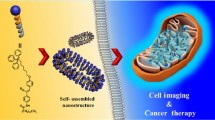Abstract
Multifunctional nanoplatforms are promising scaffolds for biomedical applications such as bioimaging, chemical/biological sensors, drug delivery, and cancer diagnosis and/or treatments. Mitochondria play crucial roles in metabolism of eukaryotic cells; therefore, mitochondria-targeting molecule such as triphenylphosphonium (TPP) is attached onto the magnetic mesoporous silica nanoparticle (Fe3O4@mSiO2). In order to track the nanoparticles, fluorescent carbon quantum dots (CDs) were conjugated to the Fe3O4@mSiO2. The as-constructed Fe3O4@mSiO2–TPP/CQD nanoplatform showed minimal cytotoxicity in various cell lines such as A549, CHO, HeLa, SH-SY5Y, HFF, and HMEC-1. External magnetic field-assisted uptake of the nanoplatform by tumor cell has been achieved promptly. More importantly, conjugation with CQDs endows the nanoplatform multicolored fluorescence that can remain bright and stable inside cells for a long time. This nanoplatform provides a multifunctional platform in targeting, imaging, and agent delivery for mitochondria-related disease diagnosis and treatment.
Access this chapter
Tax calculation will be finalised at checkout
Purchases are for personal use only
Similar content being viewed by others
References
Xu CJ, Sun SH (2013) New forms of superparamagnetic nanoparticles for biomedical applications. Adv Drug Deliv Rev 65:732–743
Kievit FM, Zhang MQ (2011) Surface engineering of iron oxide nanoparticles for targeted cancer therapy. Acc Chem Res 44:853–862
Hong X, Li J, Wang M, Xu J et al (2004) Fabrication of magnetic luminescent nanocomposites by a layer-by-layer self-assembly approach. Chem Mater 16(21):4022–4027
Jing LM, Ding K, Kershaw SV et al (2014) Magnetically engineered semiconductor quantum dots as multimodal imaging probes. Adv Mater 26:6367–6386
Bakandritsos A, Papagiannopoulos A, Anagnostou EN et al (2012) Merging high doxorubicin loading with pronounced magnetic response and bio-repellent properties in hybrid drug nanocarriers. Small 8:2381–2393
Perica K, Tu A, Richter A et al (2014) Magnetic field-induced T cell receptor clustering by nanoparticles enhances T cell activation and stimulates antitumor activity. ACS Nano 2014:2252–2260
Amendola V, Meneghetti M, Granozzi G et al (2011) Top-down synthesis of multifunctional iron oxide nanoparticles for macrophage labelling and manipulation. J Mater Chem 21:3803–3813
Liu Q, Zhang JX, Xia WL et al (2012) Magnetic field enhanced cell uptake efficiency of magnetic silica mesoporous nanoparticles. Nanoscale 4:3415–3421
Weinberg SE, Chandel NS (2015) Targeting mitochondria metabolism for cancer therapy. Nat Chem Biol 11(1):9
Zielonka J, Joseph J, Sikora A et al (2017) Mitochondria-targeted triphenylphosphonium-based compounds: syntheses, mechanisms of action, and therapeutic and diagnostic applications. Chem Rev 117(15):10043–10120
Snow BJ, Rolfe FL, Lockhart MM et al (2010) A double-blind placebo-controlled study to assess the mitochondria-targeted antioxidant MitoQ as a disease-modifying therapy in Parkinson’s disease. Mov Disord 25:1670–1674
Arcudi F, Đorević L, Prato M (2019) Design, synthesis, and functionalization strategies of tailored carbon nanodots. Acc Chem Res 52(8):2070–2079
Zhou J, Zhou H, Tang J et al (2017) Carbon dots doped with heteroatoms for fluorescent bioimaging: a review. Microchim Acta 184(2):343–368
Ding C, Zhu A, Tian Y (2013) Functional surface engineering of C-dots for fluorescent biosensing and in vivo bioimaging. Acc Chem Res 47(1):20–30
Teng X, Ma C, Ge C et al (2014) Green synthesis of nitrogen-doped carbon dots from konjac flour with “off-on” fluorescence by Fe3+ and L-lysine for bioimaging. J Mater Chem B 2(29):4631–4639
Du J, Xu N, Fan J et al (2019) Carbon dots for in vivo bioimaging and theranostics. Small 15:e1805087
Zhang Y, Shen Y, Teng X, Yan M, Bi H, Morais PC (2015) Mitochondria-targeting nanoplatform with fluorescent carbon dots for long time imaging and magnetic field-enhanced cellular uptake. ACS Appl Mater Interfaces 7:10201–10212
Acknowledgments
This work was supported by the National Natural Science Foundations of China (Grant No. 51272002) and the Technology Foundation for Selected Overseas Chinese Scholar, Ministry of Personnel of China (No. [2013]-385).
Author information
Authors and Affiliations
Corresponding author
Editor information
Editors and Affiliations
Rights and permissions
Copyright information
© 2021 Springer Science+Business Media, LLC, part of Springer Nature
About this protocol
Cite this protocol
Zhang, Y., Bi, H. (2021). Development of Mitochondria-Targeted Imaging Nanoplatforms by Incorporation of Fluorescent Carbon Quantum Dots . In: Weissig, V., Edeas, M. (eds) Mitochondrial Medicine . Methods in Molecular Biology, vol 2275. Humana, New York, NY. https://doi.org/10.1007/978-1-0716-1262-0_16
Download citation
DOI: https://doi.org/10.1007/978-1-0716-1262-0_16
Published:
Publisher Name: Humana, New York, NY
Print ISBN: 978-1-0716-1261-3
Online ISBN: 978-1-0716-1262-0
eBook Packages: Springer Protocols




